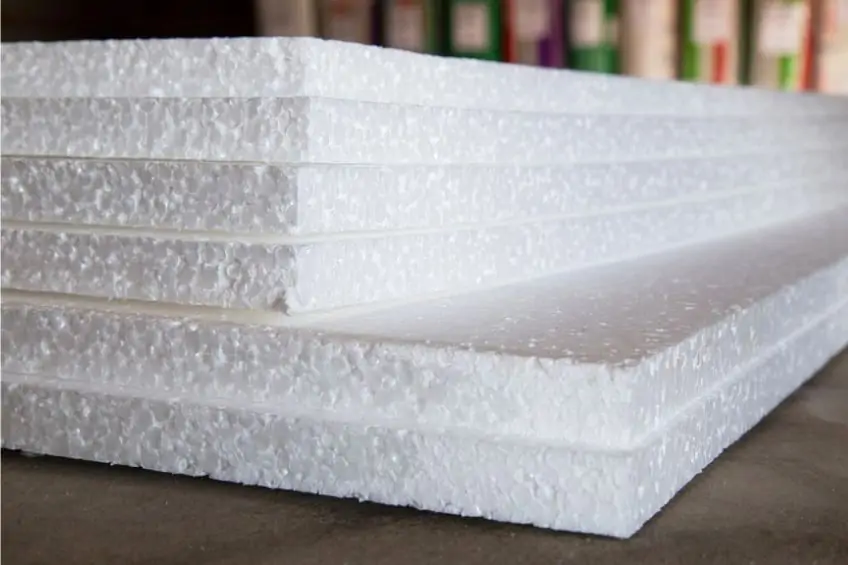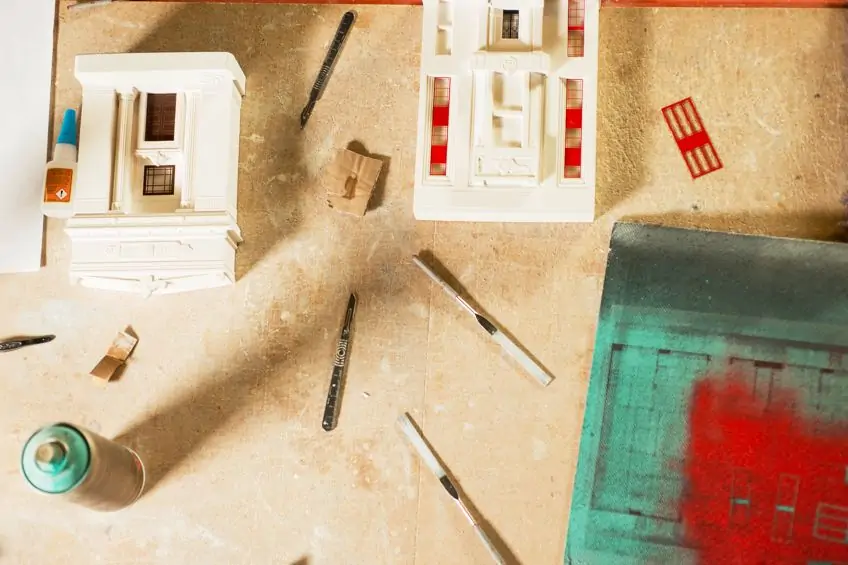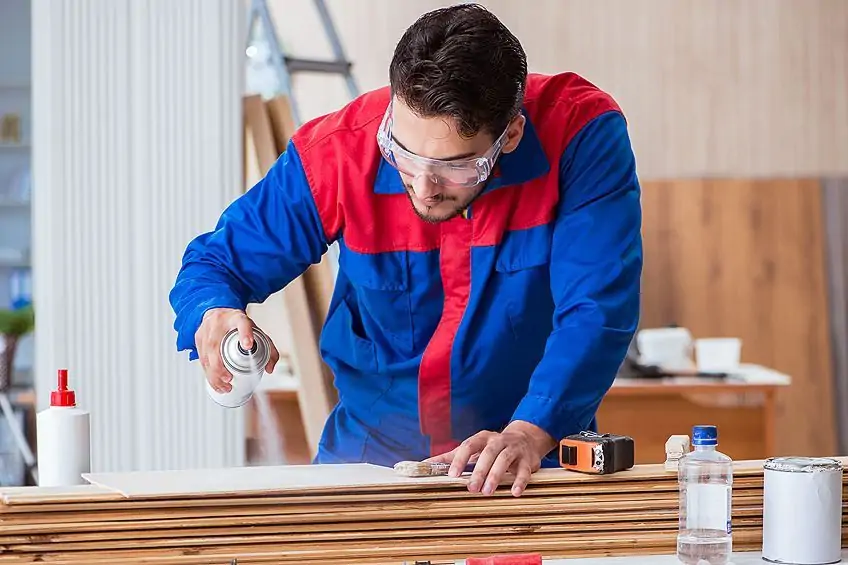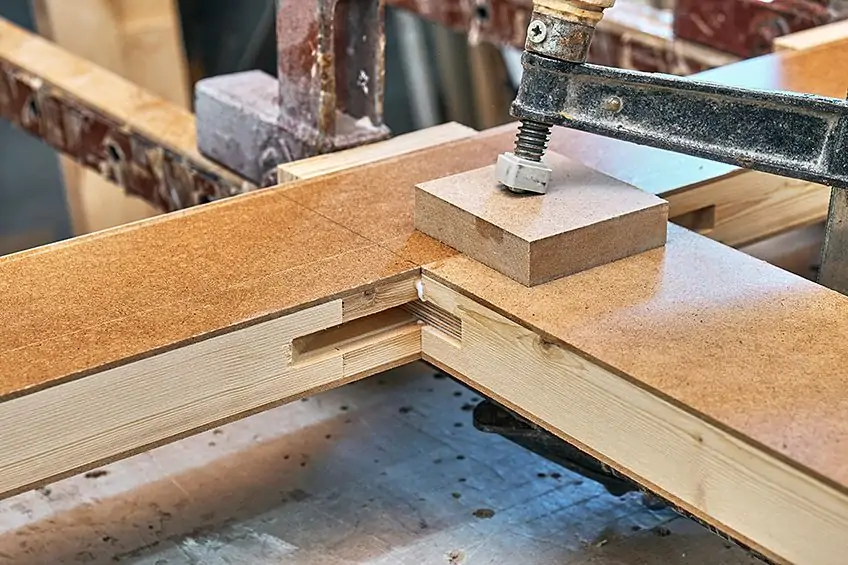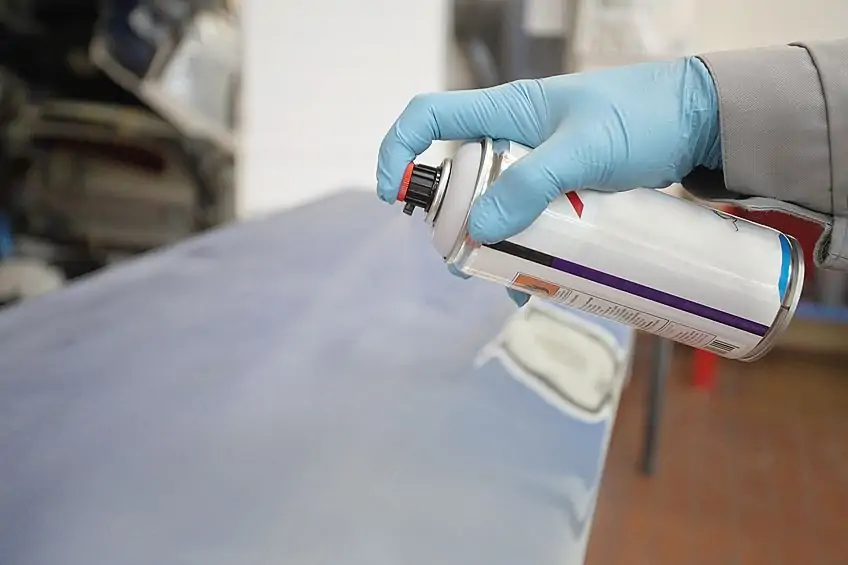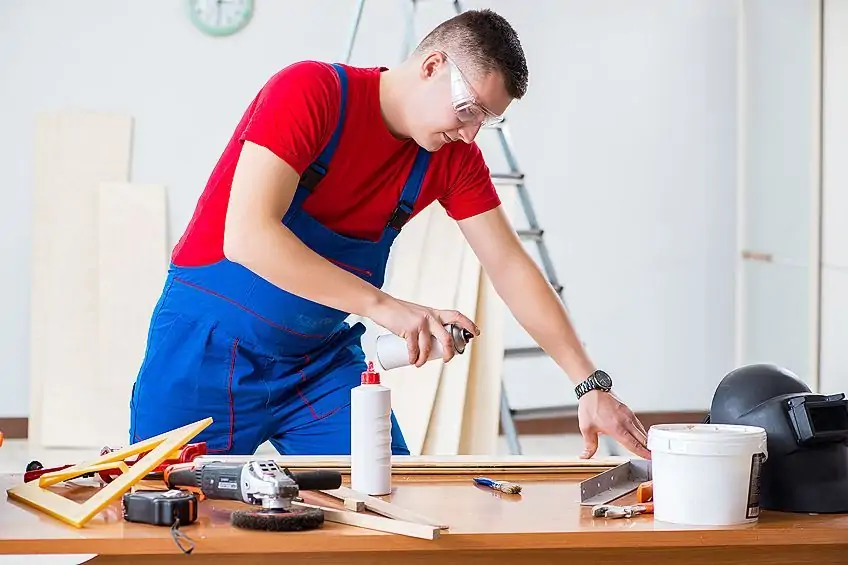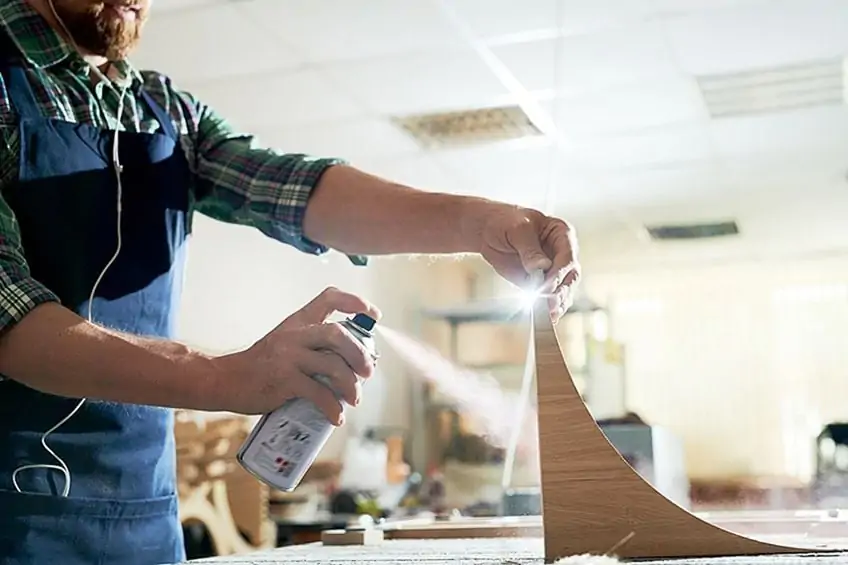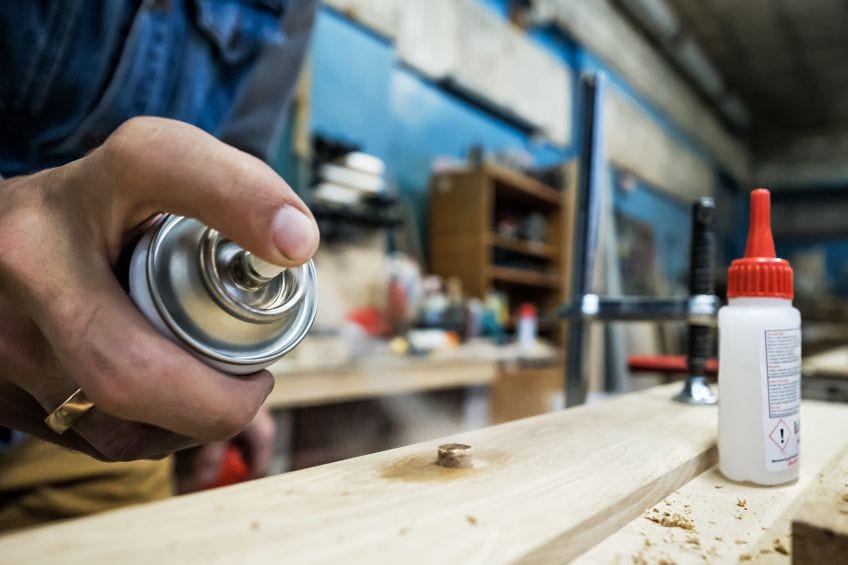Best Spray Adhesive – Reviewing the Strongest Spray Adhesive Brands
This post may contain affiliate links. We may earn a small commission from purchases made through them, at no additional cost to you. You help to support resin-expert.com
Why use spray adhesive and not the traditional wood or fabric adhesive? The main reason for using spray adhesive is that it can be applied to a larger surface area without difficulty, and it can be used at a much faster rate. Spray adhesive for fabric can also allow you to adjust your pieces if you are not happy with where you have placed them. When thinking of spray adhesive, you automatically think of adhesive in an aerosol can, however, they also come in pump spray bottles. In this article, our purpose is to help you to choose the best spray adhesive for your particular project.
Table of Contents
What Is Spray Adhesive?
Spray glue is an amazing tool to use for bonding one type of material to another, as it provides immaculate and wrinkle-free results every time. Spray adhesive is not like the conventional water-based glues, like white glue, that are often absorbed into the material. Once absorbed, it can change the materials’ composition, causing a bubbling and warping effect. Spray Adhesives are classified by two distinctive bonding techniques; the products labeled as spray fixatives can be washed out or removed later, but those labeled as best adhesive sprays form a durable and long-lasting bond.
When using the spray adhesive in an aerosol can, it applies a consistent thin layer of glue to the surface. Spray adhesive does not get absorbed into the material, preventing any staining, warping, or yellowing of your material. There is no squeezing a tube or painting with a brush that leaves ugly excessive glue all over. Rather, the glue is applied in a finely distributed and even consistency over the surface area. There are a large number of different types of spray glue on the market, and these can cater to all kinds of adhesive needs.
Spray adhesive guarantees a secure bond to most surfaces such as paper, fabric, foam, furniture, wood, plastic, leather, cardboard, school projects, and all of your everyday DIY projects no matter if the surfaces are small or large.
What Is Spray Adhesive Used for?
Spray glues are a perfect solution for a multitude of applications, but most commonly they are used in arts and craft projects, repairing of appliances and furniture, as well as mending fabric and leather. If you want to use the spray glue in areas where it is exposed to humidity, and high temperatures you need to first read the instructions, as some spray adhesives are not recommended for these particular conditions. Also, some spray glues are not recommended for use on certain vinyl fabrics or plastics.
The main benefit of using spray adhesives is that most of them dry clear and do not bleed through the material you are bonding, causing it to wrinkle. The spay glue will leave you with an almost invisible bond and preserves the original appearance of your item. The ease with which you can apply the adhesive allows for multiple coats and provides a strong bond without having to worry about the drying times.
There are also repositionable spray adhesives that give you the advantage of allowing you to reposition your pieces before it sets properly, however, you need to refer to the instructions to see if you have the correct product.
Different Types of Spray Glues
Spray glue comes in different strengths, giving you a selection that can meet your particular needs. For ordinary arts and crafts applications, the multi or general-purpose spray adhesive is the right choice to make. This type of adhesive dries clear and will not yellow with age; it also has superior strength making it perfect for those non-load-bearing repairs around the home. This type of spray glue is best used for indoor work as it is not UV compliant and will become yellow if left in the sun.
Maybe, you need to use a spray adhesive that has better and stronger bonding capabilities? Then you need to consider a high-performance spray adhesive. These types of spray glues have a much stronger bonding capacity and can effectively bond things like glass, wood, metal, foam, fabric, and most plastics. For even more demanding and intensive bonding capabilities, like bonding heavier materials, carpeting trims, or upholstery that may be exposed to high temperatures, then you need to use heavy-duty spray glue.
These types of spray adhesives are high-quality and specially designed for heavy bonding and bonds that demand higher levels of support.
Purchasing Your Spray Adhesive
Spray Adhesives are perfect for a variety of applications. For example, arts and crafts, mending fabric, or leather, repairing appliances or furniture to name a few. However, remember that not all spray glue can be used for similar purposes. Some of the spray glues are repositionable spray adhesives, allowing you to reposition your pieces before it sets, like spray adhesive for fabric. Other spray adhesives form a strong bond very quickly. These spray adhesives can also be exposed to high humidity and temperatures.
So, it is vital to know what you intend to do with the glue and then read the instructions to see if your product meets your requirements. Maybe you do not want the glue to become yellow in any way, so you need to use glue that is UV-resistant so it will remain clear even in direct sunlight. Therefore, we need to understand that certain things need to be considered before we spray glue or even buy it.
What Material or Surface Are You Using?
You need to know if the material you are going to use is porous or not. Also, do the parts you are gluing together need some form of brace to hold them in position until the glue dries? Material like rubber, wood, sponge, or rocks are porous materials, but they can be glued to other surfaces without having to be braced. However, materials like glass, marble, and plastic are not porous, and then you will need to have some form of brace to hold them in position until the glue sets.
Remember, always clean the surface properly before you apply any glue.
Strength of the Glue
Amongst the different types of spray adhesive on the market, there are different strengths for different projects. The general purpose glues are used mainly for arts and crafts projects, while the high-grade glues are more for heavy-duty jobs.
So, before you start, you should decide what the load-bearing capacity of your project is going to be. For example, your project is not going to be handled or disturbed or take any excess weight, then general purpose glue will do the trick. However, if your project is going to have some pressure applied to it after the glue has been set, then you need to go for a more high-grade glue for your project.
Drying Time of the Spray Glue
Most spray adhesives have different drying times, and you can find this information on the product instruction label. Most spray adhesives will become slightly tacky within 30 seconds, which is the time you have to reposition your pieces if needed. After this time, you may cause damage.
For the strongest bond, it is recommended you leave your project overnight before you handle it in any way.
The Best Spray Adhesives
When you are looking for a good spray adhesive for your project, there are numerous options for you to choose from and it all depends on your particular requirements. You may need something that dries fairly fast or tacks up quickly and will perform well under high-temperature conditions. Maybe you are working with wood, and you are looking for a general-purpose spray adhesive that can bond a range of different materials together? No matter what your specific needs are, there is always a spray glue that will be able to meet your needs.
Below are some of the best spray adhesives for various types of materials and their uses. You can select the one that is best for you. Also, it is important to put safety first, so you need to make sure you check the safety data sheet (SDS) to make sure the product you choose is environmentally friendly.
Strongest Spray Adhesive: GORILLA Heavy Duty Spray Glue
The Gorilla Heavy Duty Spray Adhesive is a multi-use spray glue that is easy to use, and the objects you are gluing are repositionable for around 10 minutes. When dry, it forms a permanent and extremely strong bond that is clear. The bond is also moisture-resistant and can, therefore, be used inside or outdoors. The product has a wide pad nozzle that emits a fine mist spray and provides an even and controlled application. This spray adhesive meets the volatile organic compound (VOC) standard requirements with less than 30 percent VOC level.
- The heavy-duty spray adhesive creates a durable bond
- The clear adhesive dries clear and is non-yellowing when dry
- Comfort nozzle with wide pad produces a controlled fine mist
The Gorilla Heavy Duty Spray Adhesive is ideal for use on lightweight materials like cardboard, paper, photos, and also works extremely well on metal, and wood. You can also use it as a fabric adhesive spray. The canister sits very comfortably in your hand, allowing you to spray without your hand getting tired. The adhesive is effective on many surfaces, but you will have to test it first before using it on vinyl, foam, and plastic, as it may cause some damage to these materials. It is not recommended for use on polypropylene, vinyl, plastic, or polyethylene, and must not be used on surfaces that make contact with food.
PROS
- Easy to use
- The container fits comfortably in your hand
- Repositionable within 10 minutes
- Forms a strong permanent bond
- Moisture–resistant
- You can use the adhesive indoors and outdoors
- Gives a fine controlled spray pattern
- Meets the VOC level requirement
- Can be used on several different materials including as a fabric adhesive spray
CONS
- Not to be used on polyethylene, vinyl, polypropylene, and plastic
- When using, you need a well-ventilated space
- Can cause skin and eye irritation
- Not to be used near an open flame
Best Spray Adhesive for Foam: 3M Foam Fast Spray Adhesive
The 3M Foam Spray Adhesive was designed by the 3M Company, especially for foam and fabrics, and also to help overcome problems that many existing types of glue have with their application. This will ultimately save you some time as well as money. This spray glue gives you a permanent bond and is fast-drying, and can also bond foam and fabric to a large variety of different substrates. The formulation is non-yellowing, and the spray pattern is lace-like and is deposited directly on the surfaces you want to glue, making it perfect for all kinds of projects. 3M foam spray adhesive is an excellent fabric spray adhesive.
- Spray adhesive designed specifically for foams and fabrics
- Offers a fast, aggressive tack for quick and high-stress bonds
- Provides industrial strength for demanding applications
The product gives you a fast and aggressive tack with industrial strength. You have a bonding time of 15 seconds to 30 minutes, allowing you enough time to place your materials in position. The lace-like spray pattern also provides you with high-area coverage that does not soak into the materials you are bonding. The cylinders are non-flammable, and with a low volatile organic compound (VOC) below 25 percent, makes it the perfect solution to use indoors or in confined spaces. The product is also California Air Resource Board (CARB) and South Coast Air Quality District (SCAQMD) compliant as well as being Greengard certified.
PROS
- Low VOC emissions
- Provides a permanent bond
- Fast-drying time
- Non-yellowing
- Fine lace-like spray pattern
- Industrial strength
- Non-flammable cylinders
- An excellent fabric spray adhesive
CONS
- It may be considered expensive
- Has a terrible smell
Best Tacking Spray Adhesive: KRYLON Easy Tack Repositionable Adhesive Spray
The Krylon Easy Tack Adhesive Spray is an adhesive spray that has repositioning capabilities and allows you to reposition your items if you have made a mistake. The adhesive should dry to the touch in 3 hours. Although the bond is temporary, the Krylon spray adhesive is still very strong and is ideal for all types of sewing projects, or a variety of other projects.
- Offers a repositioning bond for most lightweight materials
- The adhesive has a low odor and is non-wrinkling after drying
- The acid-free adhesive provides a long-lasting tack
Krylon spray adhesive has a low odor, is non-wrinkling, and gives repositioning bond to most lightweight materials including paper, glass, trims, photos, metal, plaster, craft foam, fabric, glitter, and many more. The spray adhesive is under pressure and is also extremely flammable. It provides you with a long-lasting tack, is acid-free and archival-safe.
PROS
- Has repositioning capabilities
- Dries to the touch within 3 hours
- Provides a strong bond and long-lasting tack
- Is very versatile and can be used on various materials
- Is acid-free
- Archival-safe
CONS
- Extremely flammable
- Cylinder under pressure
Spray Adhesive Comparison Table
We have compiled a comparison table below to help you choose the right spray adhesive for your particular project. No matter what your project may be, if it is gluing your headliner fabric, joining pieces of foam together, trim work on your car, attaching your favorite photos to an album, or doing repairs on your furniture, there is a spray adhesive that will suit your DIY project and make the process so much easier.
| Material/Substrate | Gorilla Heavy Duty Spray Adhesive | 3M Foam Fast 74 CA Spray Adhesive | Krylon Easy Tack Repositionable Adhesive Spray |
| Metal | ✔ | ✔ | ✘ |
| Fabric | ✔ | ✔ | ✔ |
| Wood | ✔ | ✔ | ✘ |
| Plastic | ✔ | ✔ | ✔ |
| Vinyl | ✘ | ✘ | ✘ |
| Cardboard | ✔ | ✔ | ✔ |
| Paper | ✔ | ✔ | ✔ |
| Polypropylene | ✘ | ✘ | ✘ |
| Polyethylene | ✘ | ✘ | ✘ |
| Photos | ✔ | ✔ | ✔ |
| Trims | ✔ | ✔ | ✔ |
| Glass | ✔ | ✔ | ✔ |
| Foam | ✔ | ✔ | ✔ |
| Dries clear | ✔ | ✔ | ✔ |
| Ease of use | ✔ | ✔ | ✔ |
| Strong fumes | ✔ | ✘ | ✘ |
| Permanent bond | ✔ | ✔ | ✔ |
| Moisture-resistant | ✔ | ✘ | ✘ |
How to Apply Spray Glue
Using a spray adhesive is not difficult, all you need to know is how to prepare the surface, how to apply the glue, and how to clean up after you have finished. We will now be guiding you through all three of these steps, allowing you to produce a powerful and quick bond to your chosen surface.
Preparation
You first need to locate a well-ventilated area to work in and make sure you have a working surface that has enough space so you can move around freely. Spray adhesive, when applied, can be fairly messy. So, ensure you protect any surface you do not want the glue to adhere to. Make sure the surface you are going to bond together is clean, free from paint, oil, wax, or any other type of residue. Make sure you test the parts before you apply the glue. The pieces should fit together properly, and nothing must be obstructing the perfect seal you want to create.
To avoid inhaling any harmful fumes, remember to always wear a mask as well as some latex or nitrile gloves.
Applying the Spray Adhesive
All spray glues are very sensitive to temperatures, which means you need to apply the glue at a temperature between 65 degrees Fahrenheit (18 degrees Celsius), and 95 degrees Fahrenheit (35 degrees Celsius). The Loctite Spray Adhesive and the LePage Multi-Purpose Spray Adhesive both come with a sealed protective nozzle. All you need to do is to turn the spray tip to get the black dot to align with the nozzle, which will give you an unobstructed spray pattern. Do not forget to shake the can thoroughly before using the glue.
Hold the spray can in a vertical position and point the spray nozzle towards the surface you want to bond. Now apply an even coat of adhesive to both of the surfaces. When you are busy spraying, make sure you hold the can at a distance of 8 to 10 inches, (or 20 to 25 cm) away from the surface. If you hold the can too close to the surface, it may result in the glue building up or puddling. You are looking to apply a consistent coat. Do not spray the glue too close to the edge of your surface, as this will result in an overflow of glue.
If you know that the pieces you are going to bond need to be repositioned, only apply a light coat. However, if you need to apply any additional coats, you need to apply them before the first coat dries.
Check the drying times on the instruction label and then wait for about two to three minutes until the glue is tacky, and then you can join the pieces together. Now apply a firm but gentle pressure to hold the pieces in place, remember that spray glue can dry fairly quickly. This should give you a secure and strong bond, but you can leave the pieces overnight to make sure the bond is secure.
Cleaning Up
When you have finished with the glue, let the can stand upright and give it a quick spray. This makes sure the valve and tip are clear. Take some mineral spirits or turpentine to clean off any glue buildup or residue, and clean the nozzle with a clean cloth. Replace the cap and store it in an upright position in a dry and room temperature place.
Spray Adhesive Tips and Tricks
Using a spray adhesive in an aerosol can is an easy and quick way to glue different kinds of materials with different substrates. Spray adhesives are versatile and can be used on numerous types of materials; it is very easy to use, dries very quickly and provides an excellent strong bond. However, as with all other processes, there are some necessary tips and instructions to follow if you want the job done right the first time.
- Not all spray glues are the same, they all have different adhering strengths or are not recommended for use on some materials. So, you need to make sure you use the right spray adhesive for your project to ensure the best results
- Make sure your working area is clean and free from grease, oil, and dust before you apply the glue
- Using a spray adhesive can be a messy process, so it is better to do it outside. You should use old newspapers or plastic to protect areas you do not want to glue
- Some spray adhesives have high volatile organic compounds (VOCs), which can be hazardous to your health so make sure you work in an area that has good ventilation
- Before you start to spray, test a small area first to see it will not cause damage, and remember to shake the container well before use
- To avoid clogging of the nozzle, hold the can upside down and spray the excess glue out. You can use some turpentine to remove any sticky residue
- Try to avoid spraying heavy thick coats of glue in small areas, rather apply thin even coats to avoid unsightly bumps
- When applying the glue, hold the can at the right distance from your surface, about 8 to 10 inches away. If you are too close, you will end up with an uneven and thicker coat that takes longer to dry. However, if you are too far away, the glue may not reach the surface and could end up on the floor
- Apply the glue in an area that is between 6 and 80 degrees Fahrenheit
- When bonding your two materials, wait for around 30 seconds before joining them
- Try to hold the can in a straight vertical position to give you an even and thin coating
- When using spray adhesive, ensure you protect your eyes and hands by wearing safety gloves and goggles
Spray adhesives can be a wonderful option when you are attempting to glue a range of different materials together. Alongside ease of use, many spray adhesives provide significant durability and very strong bonds. With our purchasing guide and instructions, you should easily be able to complete any project.
Frequently Asked Questions
Can You Use Spray Adhesive On Wood?
Most spray adhesives work well on wood, however, many woodworkers use wood glue or epoxy to glue their wood pieces. Spray adhesive is an excellent alternative, as it is quicker and covers a large area much faster.
How Long Will Spray Glue Last?
A good quality spray adhesive will last for about two years, but its shelf-life is based on various factors such as weather conditions, heat, and moisture.
How Long Does It Take Spray Glue To Dry?
The drying time of spray adhesives differs from brand to brand, as well as the composition of the glue. You need to read the instruction label to be accurate, but most spray adhesives dry within seconds and completely dry within 3 to 15 minutes.
Are Spray Adhesives Sticky?
Yes, spray adhesives are supposed to be sticky as they are required to glue two different materials together, which could be hard and smooth like wood or glass.
Does Spray Glue Leave a Residue?
If you apply the glue correctly, it should not leave a residue. However, if it does leave some residue, it can easily be removed with a wet cloth or some turpentine.



